- Know about how the Nagamandala pooja, a unique form of Naga worship, is done.
“Only someone with punya in their past birth will be able to watch this event. There are many people with a lot of money and fortune, who have spent on organizing this pooja many times, but have not been able to attend due to unfavourable circumstances each time”, say the Vaidyas historic line of performers of
this Nagamandala pooja.
The popular movie Kantara brings to fore the
tradition of bhoota kola from the Tulunadu region of coastal Karnataka and
parts of Kerala. Another folk ritual popular in this region is the Nagamandala
pooja done to appease the Naga deities.
Earlier in 2023, the historic line of performers from Udupi’s ‘Vaidya’ community came down to the newly opened Bengaluru Adiyogi center for a special performance for Sadhguru, eminent guests, and devotees. It was a treat for me to volunteer for the event. Fascinated with this unique ritual, I have researched more about it. This article is an account of my experience and findings.
Volunteering
at the Nag Panchami Event
Consecrated on 9th October 2022, Naga is the kshetrapaal deity of the Bengaluru Adiyogi center or the 'Sadhguru Sannidhi Bengaluru' as it is officially called. In 2023, we had the first Naga Panchami event at this Naga temple. It was a large event with powerful poojas and a 3-day village fair. That day started for me with a simple South Indian brunch on the lawn with fellow volunteers of the event. I finished it off quickly because the first pooja was to start in a few minutes.
Ashleshbali
Pooja
As I reached the Naga Temple, the pujari was
finishing a colorful rangoli created right in front of the deity. It showed a
brightly colored snake with a devi form and a square design that looked
uncannily like a jyotish chart.
Jyotish does have relevance to this pooja as
Ashlesha is the name of a Hindu constellation, and its presiding deity are the
Nagas. This pooja is done to appease the Naga deity. It is believed that the
Nagas can bestow various benefits on those who worship them, including
spiritual growth.
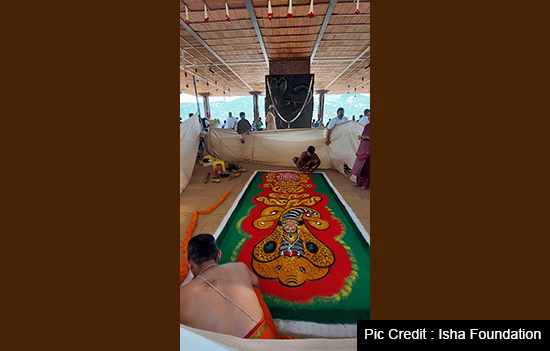 Ashlesha pooja Rangoli. Couresy author.
Ashlesha pooja Rangoli. Couresy author.
Apart from the rangoli, this pooja included a
lot of chanting and placing of flowers and other offerings onto the rangoli. As
the pooja proceeded, the traditional musicians who were a part of the
Nagamandala team started chiming in with enchanting tunes. Conspicuously, all
the pujaris wore bright, often contrasting shades of clothes. The bright hues
of their garments and the rangoli created quite an ambiance. This pooja went on
for a couple of hours and it set the tone for the more elaborate Nagamandala
pooja that was to start later in the evening.
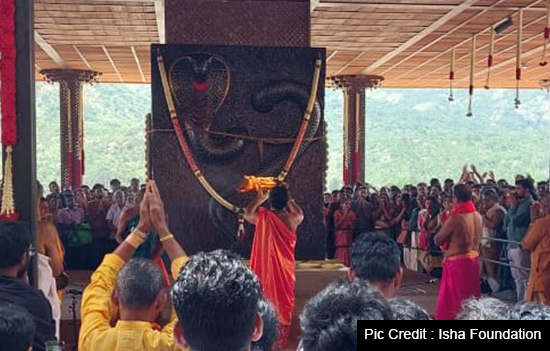 Ashleshbali pooja. Courtesy author.
Ashleshbali pooja. Courtesy author.
The Ashleshbali pooja is a preparatory step
for the Nagamandala. It is believed to remove any ill-effects of Sarpa Dosha. It also brings well-being
for the devotees, marital harmony, financial stability, grace of the Naga deity
and promotes spiritual progress.
Nagamandala
Pooja
While the Ashleshbali pooja was a smaller
affair in terms of duration and space required, the Nagamandala Pooja is a much
more elaborate affair. A larger rangoli had been created in a newly setup
pavilion. Locals tell me that this rangoli, while it seemed large to me, is
only a fraction of the size of the longer Nagamandala Pooja. The size of the rangoli
co-relates with the duration of the pooja. Nagamandala Poojas usually go on
throughout the night. Here it was to be a less common 4-hour affair.
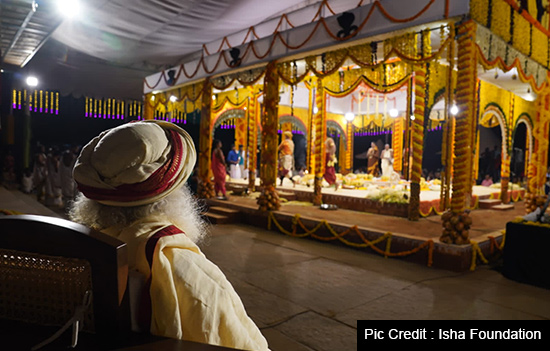 Nagamandala Pavilion.
Nagamandala Pavilion.
The pavilion itself was grandly decorated with
fragrant flowers and fruits. Bright marigold, green banana and jackfruit
leaves, torans of pineapples and pillars adorned with areca nuts created
a lavish and spectacular visual.
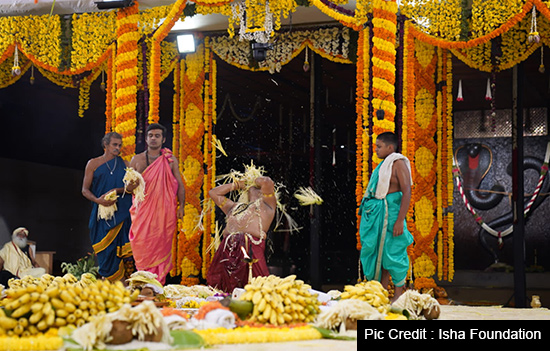 Nagamandala - Pathri smears the entire handful
of flowers on his face.
Nagamandala - Pathri smears the entire handful
of flowers on his face.
After various offerings to the naga deities, the ritual starts with one of the performers called the ‘Pathri’ taking a handful of areca nut flowers. Sacred water is poured over them. He is constantly muttering mantras while the Vaidya performer grandly sings the praises of Naga. A chorus of traditional music plays in the background. The Pathri soon smears the entire handful of flowers on his face. He does this a few times. His eyes bulge out and his head movements mimic that of a snake. In a few minutes, starts the dance of the nagas. The Pathri, is considered possessed with the Naga deity. While Vaidya plays the role of the Naga kannika (female serpent).
For the next few hours, a nuanced dance of the
Pathri and the Naga Kannika takes place around the sacred rangoli design (also
called mandala) in the spectacular mandapam. The dance is not simple circles
around the mandala, but rather in a curious snake-like movement twisting and
turning in loops. The dance steps sync with the mandala design.
A Tulu local and fellow Isha volunteer who has grown up seeing these rituals told me, “It is like the dance is unlocking the mandala that has been created on the floor. That’s the best way I can explain the intricate movements the Pathri and Vaidya are doing around the mandala. They are not random circles of dance performed around the mandala, these movements are specific and an integral part of the ritual.”
Many online sources suggest this performance
to be a dance depicting the mating ritual of the snakes. However, this is not
the best interpretation.
Nagendra T, Associate Professor, Department of
Visual Arts, Assam University explains well in his research paper on
Nagamandala (source),
Vaidya community played the role of Nagini (the female serpent or Nagakannika), also as an Ardhanareeshwara. Ardhanari communicates with Naga as a friendship, quarrel, humble, tease, love, etc. Nagakannika is the form of prakruti and nagapatri is the form of Shivapurusha. At the middle of the ritual there is an activity of Nagapatri and Nagini both embraced it is called as 'milana', this stage is said to be 'prakrutipurusha milana'.
As with the many Indic rituals and worship,
this is also about divine union of the creation (Prakruthi) with the source of
creation (Shiva Purusha).
The lavish mandapam with the brightly attired
performers moving around the mandala and the constant symphony of traditional
instruments created a hypnotic charm to the performance.
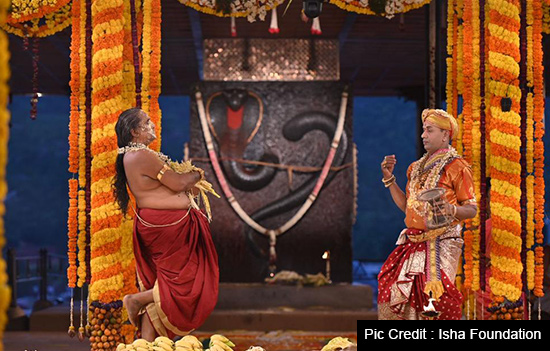 Pathri & Naga Kannika (historically played
by the Vaidya community)
Pathri & Naga Kannika (historically played
by the Vaidya community)
Is it a Pooja? Is it a dance? Is it a play?
What is this Nagamandala ritual, I wondered. Many questions would come up if we
saw this ritual with our questioning mind.
Sadhguru said at the start of the event “In today’s world everything needs to be logically correct. Being logically correct will take us to a certain point beyond that unless you know how to evolve your logic where it will touch the magic of life, otherwise we get stopped by our own logic.”
This was an event where I could not logically
reason out the process at all, and I realised that the only way to experience
it was to leave my logic and immerse in the kaleidoscopic magic. It is said
this Pooja helps one develop a sense of devotion and surrender to the divine,
which in turn aids devotees tremendously on their spiritual path.
In a conversation with the Vaidyas, translated by Shravan, he says, “This event should be watched with devotion and the prasadam distributed at the end of the event is very significant. Called ‘panchachoornam’, it is made of 5 ingredients – turmeric, slaked lime, rice husk, rice flour and traditional green leaves.”
The Youtube channel of Isha
Foundation live streamed this performance reaching lakhs of viewers from
around the world.
With this event, I am deeply satisfied to get
a glimpse of one more layer of Indic culture and hope that over time I can know
more about this fascinating tradition.
Author Priyanka Dalal has a profound love for spiritual exploration and travel. She documents her adventures on her blog MapRoute and youtube channel
InSpirituality